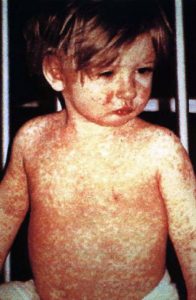Modern (1940’s-present)
34
Measles, Mumps, and Rubella
Saige Hinton
introduction

The measles, mumps, and rubella (MMR) vaccine’s primary purpose is to immunize against these childhood diseases in an attempt to eradicate them and their risk of permanent disabilities or death (Linwood, Davidson, Harmon, 2016). Because the MMR vaccine is administered to millions of healthy adults and children, the FDA and CDC have implemented high safety standards to ensure the safety of its members while still working towards preventing diseases. Before a vaccine is even allowed to be released to the public, it undergoes a plethora of tests in a lab that take several years before the FDA uses the results and information from these tests to decide if the vaccine is ready to launch clinical trials. Clinical trials begin with 20-100 volunteers, which gradually increases to thousands of people for another several years so that the FDA can configure the appropriate dosage and identify potential side effects and/or reactions. The US Department of Health and Human Services claimed that, “Once a vaccine is released to the public, upon making each batch, the vaccines are all tested to make sure they are potent, sterile, and pure” (“Vaccine Safety,” 2017). “Once a vaccine is released to the public, upon making each batch, the vaccines are all tested to make sure they are potent, sterile, and pure.”Because of these tests, the FDA was able to identify that the MMR vaccine shouldn’t be given to infants younger than 12 months and should be given in two doses; one dose between 12-15 months and the second between the ages of 4-6 (Linwood, Davidson, Harmon, 2016). In addition to the safety of the MMR vaccine, this combined vaccine has also provided many economic benefits as well as helped move society towards community immunity; however, it’s controversy in regard to religious and medical freedoms remains prevalent.
economic benefits
People who are immunized against mumps, measles and rubella not only experience economics benefits, but also bring about social value. Immunizations prevent the medical expenses of treating a disease by preventing the diseases from occurring. The table below is data gathered from the CDC in 2014 displaying, on average, how much it would cost to treat each disease as well as the probability of hospitalization.
| Disease | Probability of Hospitalization | No. of Hospitalization Days | Cost Per Hospitalization | Cost Per Outpatient Visit |
|---|---|---|---|---|
| Measles | 11-100% | 1.3-10.9 | $4,032-46,060 | $88-526 |
| Mumps | 1-100% | 2.8-8.7 | $102,584 | $110-556 |
| Rubella | 0.1-100% | 2.6-8.7 | $10,765 | $89-651 |
| Congenital Rubella Syndrome | ||||
|
100% | 13.6 | $62,233 | $110 |
|
100% | 8.9 | $37,082 | |
|
100% | 2.2 | $8,7686 |
Table 1. Probabilities and costs of hospitalizations, and outpatient visits for selected vaccine preventable diseases in 2013 (“VFC Publications: Supplement,” 2017).
Vaccinating against measles, mumps and rubella allows for individuals and families to save thousands of dollars by not having to undergo treatment for these diseases. The MMR vaccine not only improved health but has also allowed for individuals to contribute to economic growth by displaying better physical, cognitive, and educational performance (Toumi, Ricciardi, 2015). Because these vaccinated individuals are not disabled by these diseases, they are able to maintain a healthier and sustainable life as opposed to those who are weighed down by the physical, emotional and economic disparities associated with measles, mumps and rubella.
community immunity

The MMR vaccine is an essential part in establishing community immunity within society. Community immunity, or herd immunity, occurs when a majority of a community is immunized against a disease, allowing for little opportunity for an outbreak to take place because the spread of contagious diseases is contained (“Vaccines Protect Your Community,” 2017). Many religions and medical conditions restrict individuals from being vaccinated; however, if a majority of a community is vaccinated, then this allows for people to still exercise their religious and medical freedoms because pathogens are less likely to find a susceptible host due to herd immunity. This is also a huge reason as to why public schools require vaccinations in an attempt to establish herd immunity within the school system. Most of the recent measles cases occurred among school-age children whose parents chose not to have them vaccinated and a number of these patients were hospitalized, including infants and young children. Because of the widespread use of vaccines, measles, mumps, and rubella cases aren’t as intense; however, these diseases still occur. In 2006 a record number of cases of mumps were reported in the United States and in 2008 the United States had the highest number of reported cases of measles in more than 10 years (“MMR Single Dose Vaccine Questions,” 2009). Since then, more schools are requiring vaccinations as well as the implication of other regulations in the workforce. Maintaining community immunity is important in allowing for these case numbers to reach zero.
mmr vaccine controversy
The MMR vaccine has faced a plethora of criticism due to parental attitudes, human rights activists and false information broadcasted in the media. In 1998, Dr. Andrew Wakefield published a paper titled The Lancet, which has now been retracted 12 years later due to its skewed data and false information linking the MMR vaccine to autism. Even though the paper has been retracted and Dr. Wakefield has lost his license to practice medicine, many autism advocacy groups and parents continue to believe that what Wakefield wrote is true (Eggertson, 2010). The Autism Speaks Organization published one of the biggest ASD (Autism Spectrum Disorder) studies about researchers who analyzed the health records of 95,727 children, including more than 15,000 children unvaccinated at age 2 and more than 8,000 still unvaccinated at age 5. Nearly 2,000 of these children were considered at risk for autism because they were born into families that already had a child with the disorder. Researchers voiced, “Consistent with studies in other populations, we observed no association between MMR vaccination and increased ASD risk. We also found no evidence that receipt of either one or two doses of MMR vaccination was associated with an increased risk of ASD among children who had older siblings with ASD (“No MMR Vaccine-Autism Link in Large Study,” 2015). “…We observed no association between MMR vaccination and increased ASD risk.” However, parents have already fed into this “fake news” in the media and don’t vaccinate their children. Many parents who have concerns about vaccination read both medical and non-medical literature to try to settle their concerns; however, their views are ill-informed and unjustified. MMR uptake rates have been falling since the early 1990’s as a result of speculation regarding potential side effects of the vaccine, and rates will continue to fall if the public’s confidence in the MMR vaccine is not restored (Buckley, 2007). Many people also argue that requiring the MMR vaccine in public schools violates our freedoms as American citizens. Nonetheless, public schools are government property. Parents who choose to vaccinate are not only protecting their own child, but also friends, families, schoolmates, and future generations. Vaccinations ensure the safety of children in public schools who are striving to get an education instead of a contagious and harmful disease. Society can’t stop vaccinating because even though the disease rates are low, they are not all zero and the population could become vulnerable to a major outbreak (Espejo, 2014, p.16). The requirement for major vaccines in public schools helps minimize the risk of an outbreak by maintaining herd immunity to ensure the safety of its students and the generations to come. If society was more exposed to factual information as opposed to “fake news,” the controversy could be put to rest and instead the public could work towards the eradication of harmful diseases.
Conclusion
The MMR vaccine is an influential advancement that has allowed for us to improve the quality of life for society through economic benefits and the increase in social value. It has allowed for protection of individuals who are more susceptible to these diseases and has helped protect those who aren’t able to physically receive the vaccine through community immunity. Although there is an abundance of controversy in regards to this vaccine, the FDA and CDC have provided a plethora of precautions and tests that each vaccine must undergo before being released to the public. “Fake news” is the root of many controversies in regard to the MMR vaccine; however, science disproves them.
- Multiple Choice: What is community immunity?
A) When a majority of a community is immunized against a disease, allowing for little opportunity for an outbreak to take place.
B) When an entire community is immunized against a disease, allowing for little opportunity for an outbreak to take place.
C) When the government targets a population and forced them to be immunize. - True/False: There is a study that confirms that the MMR vaccine causes autism.
- Short Answer: Explain the positive economic impacts of vaccinating against MMR.
Sources
Buckley, E. (2007). MMR vaccine. In S. Ayers, A. Baum, C. McManus, & et. al. (Eds.), Cambridge handbook of psychology, health and medicine (2nd ed.). Cambridge, UK: Cambridge University Press. Retrieved from http://libproxy.clemson.edu/login?url=https://search.credoreference.com/content/entry/cupphm/mmr_vaccine/0?institutionId=1831
Eggertson, L. (2010, March 9). Lancet retracts 12-year-old article linking autism to MMR vaccines. Retrieved October 8, 2019, from https://www.ncbi.nlm.nih.gov/pmc/articles/PMC2831678/.
Espejo, R. (2014). Should Vaccinations Be Mandatory. Green Haven Press.
Linwood, A., Davidson, T., & Harmon, A. (2016). MMR vaccine. In Gale (Ed.), Gale encyclopedia of children’s health: Infancy through adolescence (3rd ed.). Farmington, MI: Gale. Retrieved from http://libproxy.clemson.edu/login?url=https://search.credoreference.com/content/entry/galegchita/mmr_vaccine/0?institutionId=1831
MMR Single Dose Vaccines Questions. (2009, October 26). Retrieved November 10, 2019, from https://www.cdc.gov/vaccines/hcp/clinical-resources/mmr-faq-12-17-08.html.
No MMR Vaccine-Autism Link in Large Study. (2015, April 21). Retrieved November 19, 2019, from https://www.autismspeaks.org/science-news/no-mmr-autism-link-large-study-vaccinated-vs-unvaccinated-kids?gclid=EAIaIQobChMI6_CMoun25QIVGovICh1CqwzSEAAYASAAEgKzUfD_BwE.
Toumi, M., & Ricciardi, W. (2015, August 12). The Economic Value of Vaccination: Why Prevention is Wealth. Retrieved from https://www.ncbi.nlm.nih.gov/pmc/articles/PMC4802700/
Vaccines Protect Your Community. (2017, December). Retrieved from https://www.vaccines.gov/basics/work/protection
VFC Publications: Supplement. (2017, April 23). Retrieved October 8, 2019, from https://www.cdc.gov/vaccines/programs/vfc/pubs/methods/index.html#.
(2017, December). Vaccine Safety. Retrieved from https://www.vaccines.gov/basics/safety
Figures
“Bottles of Vaccine Vials” by FDA is in the Public Domain
” Measles. This child shows a classic day-4 rash with measles.” by CDC/NIP/Barbara Rice is in the Public Domain
